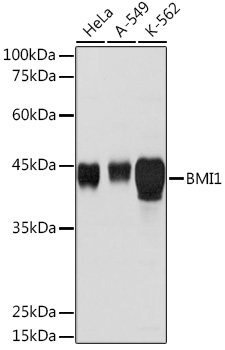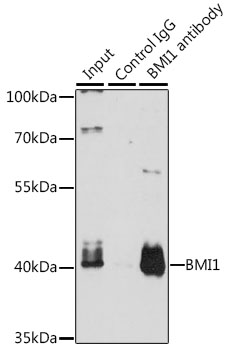Epigenetics & Nuclear Signaling Antibodies 1
Anti-BMI1 Antibody (CAB0211)
- SKU:
- CAB0211
- Product Type:
- Antibody
- Reactivity:
- Human
- Reactivity:
- Mouse
- Reactivity:
- Rat
- Host Species:
- Rabbit
- Isotype:
- IgG
- Antibody Type:
- Polyclonal Antibody
- Research Area:
- Epigenetics and Nuclear Signaling
Description
| Antibody Name: | Anti-BMI1 Antibody |
| Antibody SKU: | CAB0211 |
| Antibody Size: | 20uL, 50uL, 100uL |
| Application: | WB IP |
| Reactivity: | Human, Mouse, Rat |
| Host Species: | Rabbit |
| Immunogen: | Recombinant fusion protein containing a sequence corresponding to amino acids 120-326 of human BMI1 (NP_005171.4). |
| Application: | WB IP |
| Recommended Dilution: | WB 1:500 - 1:2000 IP 1:50 - 1:100 |
| Reactivity: | Human, Mouse, Rat |
| Positive Samples: | HeLa, A-549, K-562, Mouse heart, Mouse thymus, Rat thymus, Rat testis |
| Immunogen: | Recombinant fusion protein containing a sequence corresponding to amino acids 120-326 of human BMI1 (NP_005171.4). |
| Purification Method: | Affinity purification |
| Storage Buffer: | Store at -20'C. Avoid freeze / thaw cycles. Buffer: PBS with 0.02% sodium azide, 50% glycerol, pH7.3. |
| Isotype: | IgG |
| Sequence: | EDKR IITD DEII SLSI EFFD QNRL DRKV NKDK EKSK EEVN DKRY LRCP AAMT VMHL RKFL RSKM DIPN TFQI DVMY EEEP LKDY YTLM DIAY IYTW RRNG PLPL KYRV RPTC KRMK ISHQ RDGL TNAG ELES DSGS DKAN SPAG GIPS TSSC LPSP STPV QSPH PQFP HISS TMNG TSNS PSGN HQSS FANR PRKS SVNG SSAT SSG |
| Gene ID: | 648 |
| Uniprot: | P35226 |
| Cellular Location: | Cytoplasm, Nucleus |
| Calculated MW: | 36kDa |
| Observed MW: | 43KDa |
| Synonyms: | BMI1, FLVI2/BMI1, PCGF4, RNF51, flvi-2/bmi-1, Bmi1 |
| Background: | This gene encodes a ring finger protein that is major component of the polycomb group complex 1 (PRC1). This complex functions through chromatin remodeling as an essential epigenetic repressor of multiple regulatory genes involved in embryonic development and self-renewal in somatic stem cells. This protein also plays a central role in DNA damage repair. This gene is an oncogene and aberrant expression is associated with numerous cancers and is associated with resistance to certain chemotherapies. A pseudogene of this gene is found on chromosome X. Read-through transcription also exists between this gene and the upstream COMM domain containing 3 (COMMD3) gene. |
| UniProt Protein Function: | BMI1: Component of a Polycomb group (PcG) multiprotein PRC1- like complex, a complex class required to maintain the transcriptionally repressive state of many genes, including Hox genes, throughout development. PcG PRC1 complex acts via chromatin remodeling and modification of histones; it mediates monoubiquitination of histone H2A 'Lys-119', rendering chromatin heritably changed in its expressibility. In the PRC1 complex, it is required to stimulate the E3 ubiquitin-protein ligase activity of RNF2/RING2. Component of a PRC1-like complex. Interacts with RING1 and RING2. Interacts vwith CBX7 and CBX8. Interacts with SPOP. Part of a complex consisting of BMI1, CUL3 and SPOP. Interacts with E4F1. |
| UniProt Protein Details: | Protein type:Ubiquitin ligase; Ubiquitin conjugating system; Ligase; EC 6.3.2.-; Oncoprotein; Motility/polarity/chemotaxis Chromosomal Location of Human Ortholog: 10p11.23 Cellular Component: nucleoplasm; heterochromatin; nuclear body; cytoplasm; PcG protein complex; nucleus; ubiquitin ligase complex Molecular Function:protein binding; zinc ion binding; sequence-specific DNA binding; ubiquitin-protein ligase activity; chromatin binding Biological Process: transcription, DNA-dependent; in utero embryonic development; positive regulation of immature T cell proliferation in the thymus; negative regulation of transcription from RNA polymerase II promoter; humoral immune response; embryonic skeletal morphogenesis; segment specification; rostrocaudal neural tube patterning; positive regulation of fibroblast proliferation; regulation of gene expression; positive regulation of ubiquitin-protein ligase activity; histone ubiquitination; positive regulation of B cell proliferation; DNA methylation; somatic stem cell division; hemopoiesis; histone acetylation; brain development |
| NCBI Summary: | This locus represents naturally occurring read-through transcription between the neighboring COMM domain-containing protein 3 and polycomb complex protein BMI-1 genes on chromosome 10. The read-through transcript produces a fusion protein that shares sequence identity with each individual gene product. [provided by RefSeq, Feb 2011] |
| UniProt Code: | P35226 |
| NCBI GenInfo Identifier: | 22258801 |
| NCBI Gene ID: | 100532731 |
| NCBI Accession: | P35226.2 |
| UniProt Secondary Accession: | P35226,Q16030, Q5T8Z3, Q96F37, |
| Molecular Weight: | 36,949 Da |
| NCBI Full Name: | Polycomb complex protein BMI-1 |
| NCBI Synonym Full Names: | COMMD3-BMI1 readthrough |
| NCBI Official Symbol: | COMMD3-BMI1 |
| NCBI Protein Information: | COMMD3-BMI1 read-through protein |
| UniProt Protein Name: | Polycomb complex protein BMI-1 |
| UniProt Synonym Protein Names: | Polycomb group RING finger protein 4; RING finger protein 51 |
| Protein Family: | Polycomb complex protein |
| UniProt Gene Name: | BMI1 |
| UniProt Entry Name: | BMI1_HUMAN |









